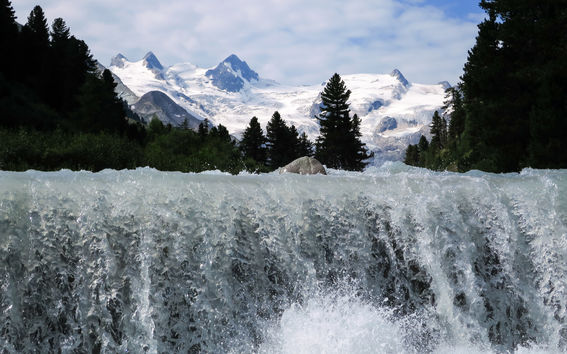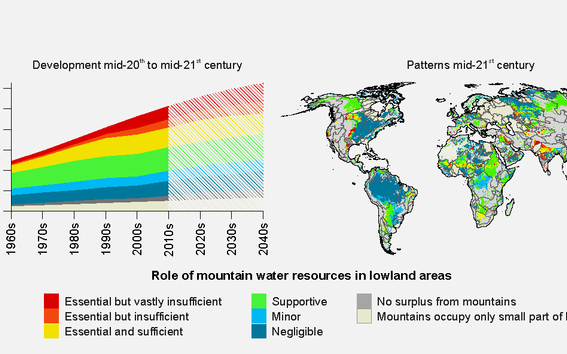A quarter of the world’s lowland population depends critically on mountain water resources

Water is a key resource for the twenty-first century, and many lowland regions depend on water resources originating in mountain regions, not least for strongly expanded irrigation of agricultural land. A study just published in “Nature Sustainability” led by the University of Zurich quantifies this dependence for the first time by comparing water supply and consumption in the world’s lowland areas with runoff contributions from the mountains. Based on a high-resolution global model, the study provides detailed information on the dependence on mountain water resources for each grid cell of five arc minutes (~9 km at the equator). This allows for highly differentiated insights into regional characteristics and differences.
“Until now, research has focused mainly on river basins that originate in High Mountain Asia," says Daniel Viviroli from the Department of Geography at the University of Zurich, first author of the study. “But in many other regions, irrigated agriculture is heavily dependent on water from mountainous areas, such as in the Middle East and North Africa, as well as parts of North America, South America and Australia.”
This dependence has increased strongly since the 1960s – despite more efficient water use and thus declining per-capita water consumption. Whereas only 7 percent of the lowland population was strongly dependent on contributions of mountain areas at that time, this figure is projected to rise to 24 percent (1.5 billion people) by mid-twenty-first century. For their analyses, the researchers assumed a “middle of the road” scenario in terms of population growth as well as technological, economic and social development.

“Ensuring the function of mountains as ‘water towers’ should be a major concern of the world’s lowland populations," says Associate professor Matti Kummu from Aalto University, who was part of the study team together with PhD researcher Marko Kallio. Sustainable development of mountain regions is therefore essential, for example by preventing agricultural overuse and ensuring the functioning of ecosystems. In addition, climate action is of paramount importance: due to rising temperatures, meltwater peaks from the mountains already occur sometimes several weeks earlier and thus arrive at a less favourable time for agriculture.
Adjustments in water management will be necessary, and possibly also new infrastructure such as dams and water transfers. “However, technical solutions go hand in hand with major ecological damage, and some rivers, such as the Indus, have little potential for expansion” says Viviroli. For the future it will be crucial that lowland and mountain regions work closely together despite cultural, social and economic differences.
Read more:
Daniel Viviroli, Matti Kummu, Michel Meybeck, Marko Kallio, Yoshihide Wada: Increasing dependence of lowland population on mountain water resources. Nature Sustainability 2020 https://doi.org/10.1038/s41893-020-0559-9
Read more news

Start the year with new insights – apply for FITech's spring courses!
Deepen your knowledge with courses from Finnish universities of technology, designed to meet the demands of the working life and help deepen your expertise for free.
Seizing opportunities — Vuong Vo’s path led through Aalto University and VTT to build the protein factory of the future
Vuong Vo's path led through Aalto University and VTT to a startup, where he is helping build the protein factory of the future.Growing Materials, Growing Ideas: Inside the BioMaker Studio
At Aalto University’s BioMaker Studio, initiated by Ena Naito, students and researchers experiment with living materials, from algae to mycelium, creating an open, interdisciplinary space where design, biology, and collaboration grow together.






